COVID-19 has increased the pace of eCommerce growth. The flip side of that growth is that competition is growing too. To keep up with competitors, eTailers need to know what the biggest challenges in eCommerce will be moving forward.
In this post, we look at eCommerce challenges facing eTailers in the coming year, including:
- Higher customer expectations
- Expanded customer options
- Increased difficulty in attracting customers
- Increased importance in using technologies to automate
- Continued uncertainty
Before we dig in, let’s look at the state of the eCommerce business market today.
The eCommerce Landscape in 2020 and Beyond
Shopping online in 2020 moved from a convenience to a necessity because of COVID-19. The number of online shoppers jumped 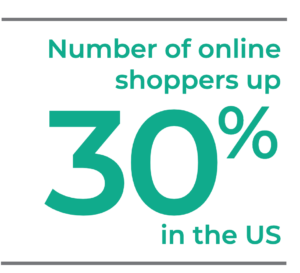 30% in the US — a number not expected until 2022.1 And globally, eCommerce sales in July were up 19% from 2019.2
30% in the US — a number not expected until 2022.1 And globally, eCommerce sales in July were up 19% from 2019.2
The shift to online shopping let eTailers weather the pandemic better than many brick-and-mortar stores. It also forced some traditional retailers to go entirely online or shift more focus to the online market. And the shift to online shopping isn’t expected to change.
According to eMarketer, “The pandemic has only accelerated an ongoing shift to the [eCommerce] channel. Even as stores reopen and brick-and-mortar sales rebound, we forecast that eCommerce will lose just a 0.1% share of total retail sales in 2021, before gaining more than 1 percentage point each year through 2024.”3
The Biggest Challenges Facing eCommerce in 2021
Added opportunities bring changes that can lead to challenges. The biggest eCommerce challenges for eTailers in 2021 will come from customer expectations and options as well as continued uncertainty, which will only be heightened because of increased online shopping.
1. Higher Customer Expectations
2020 didn’t reduce online shoppers’ high expectations. It may have even increased them. And customer expectations won’t diminish in 2021, which will make high customer expectations one of the biggest challenges in eCommerce in the months ahead.
Customers expect a lot, including things they may not even yet realize they want, including:
- Low-cost or free returns.
- Free shipping.
- A website where it’s easy to find information about products and policies.
- 24 x 7 customer service options right on your eCommerce site.
- Personalization.
- A consistent shopping experience across their phones, their desktops, and mobile apps.
- The ability to use any number of digital payment options, including PayPal, Apple Pay, AliPay, Masterpass, Visa Checkout, GooglePay, Payoneer, WeChat, and more, as well as credit and debit cards.
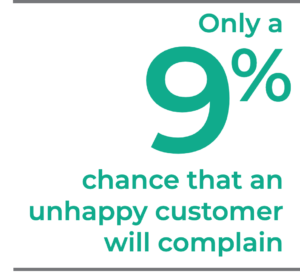 The US Federal Trade Commission (FTC) in July reported a spike in consumer complaints about online shopping.4 The Department of Trade and Industry (DTI) in the Philippines also reported an increase in complaints from online shoppers in 2020.5
The US Federal Trade Commission (FTC) in July reported a spike in consumer complaints about online shopping.4 The Department of Trade and Industry (DTI) in the Philippines also reported an increase in complaints from online shoppers in 2020.5
While many complaints are about undelivered packages, others are for more subtle reasons and may never be reported. Lee Resources found that there’s only a 9% chance that an unhappy customer will complain as compared to just going elsewhere.
The Takeaway
As an eTailer, your challenge is to address customer expectations at every turn. You want to keep your eye on what you have in place to make sure it’s working and watch what’s trending for the future.
Many expectations aren’t new but are worth revisiting. For example, auditing your eCommerce website’s usability lets you ensure you keep pace with competitors and customer expectations.
Ensure your customer service is high-quality, keep response time low, and responses friendly. Don’t dismiss the majority of consumers who won’t just abandon your shopping cart, but abandon your brand after a bad shopping or service experience.
Be transparent with your return and refund policies and make returns easy on customers. Offer free shipping if you can, even if you only offer it at certain times or in exchange for a minimum purchase amount. Think of the success of free shipping with the purchase of $25 worth of eligible items on Amazon.com or free 2-day shipping with an Amazon Prime membership.
Offer at least the key digital payment options, such as PayPal and Apple Pay, and AliPay if you sell in Europe.
Also, watch for trends and what your competitors are doing. Try and get there first or, at least, not too late. Here are a few “trends” that have moved or are moving from trendy to commonplace.
Augmented Reality (AR)
AR lets online shoppers see furniture in their homes, virtually try on clothing, try out makeup or eyeglasses, and more. And increasing competition online for market share, especially with brick-and-mortar retailers moving online, make AR more than a new trend. IKEA is using AR to let shoppers see furniture in their homes before buying.
AR may turn out to be a competitive advantage, especially if you sell something that consumers want to experience before buying. If another eTailer lets shoppers “try on” an item and you don’t, you may end up at a competitive disadvantage.
A note of caution though, poorly implemented AR can go wrong.
Personalization
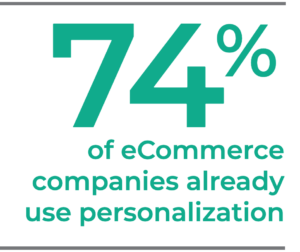 Personalization in online commerce is something customers expect. 74% of eCommerce companies already use personalization.6 And that percentage is expected to increase to more than 90% by the end of 2021.6
Personalization in online commerce is something customers expect. 74% of eCommerce companies already use personalization.6 And that percentage is expected to increase to more than 90% by the end of 2021.6
Bottom line: if you don’t meet — or better exceed — your customers’ expectations, your customers may shop around. And with growing online eCommerce options, they have plenty of other places to go.
You don’t have to rush out and add AR tomorrow, but you do want to keep your finger on what your customers expect and how you might delight them with experiences they don’t expect.
2. Expanded Customer Options
Customers’ options for where and how they shop are expanding too, which presents more potential challenges in eCommerce.
Local eCommerce Hubs
New shopping trends include local eCommerce hubs that bring the convenience of hometown shopping online. Sites like Shop Where I Live in the US, Le Panier Bleu in Quebec, Canada, and Angers Shopping in France, extend shoppers options. Many are also free for merchants.
And these local hubs are doing well during the pandemic. Bookshop.org, a US online bookstore that supports local bookstores, has chipped 2% out of Amazon’s market share for books.7
Social Shops and Catalogs
Social selling, such as through a Facebook Shop or Catalog or Instagram, is also chipping into the eCommerce landscape. The shops keep buyers right on the social platform to make purchases rather than sending them to the merchant’s website (available only in the US right now). Shops integrate with users’ news and advertising feeds and use habits to offer a level of personalization not found anywhere else.
Cross-Border Selling and Local Fulfillment
New competition doesn’t just come from more online sellers or brick-and-mortar stores moving online. It comes from companies increasingly selling to consumers in other countries. Where one company may have had the majority market share in its native country, increasingly companies from other across the border are eating into that market share.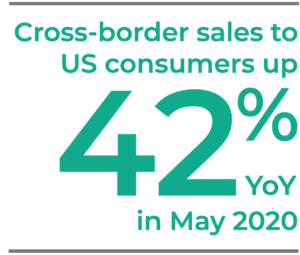
Cross-border selling was growing before COVID-19 and has only expanded with the pandemic. Cross-border sales to US consumerswere up 42% YoY in May 2020, and 10.2% for January to June 2020.8 And 23.55% of online sales in Europe are cross-border sales.9
Merchants are also adding local fulfillment centers to meet cross-border needs faster. And it’s not just Amazon setting up fulfillment centers in local areas. Christies Direct is a leading global supplier of dog grooming products and a Finch client. The company does cross-border selling and has established a warehouse in the US in addition to its original warehouse in Ireland.
Subscription Commerce
Subscription commerce is another fast-growing trend whose growth has increased due to COVID-9. Subscription services cover collecting items for customers, replacing items (such as through autoship), and membership subscriptions that give customers access to benefits they wouldn’t have otherwise.
Amazon.com offers a variety of subscription boxes for kids and adults. Amazon Prime is subscription commerce. Dollar Shave Club sends members regular deliveries of razor blades and grooming products. GlossyBox offers repeat deliveries of new beauty products. It started in Berlin, Germany, and has since expanded globally.
Gartner forecasts that two-thirds of D2C eCommerce companies will offer a subscription service of some kind by 2023.10
The Takeaway
The takeaway is to stay aware. A subscription service may not be appropriate for your product line, but autoship might. If tapping into more market share or extending customer orders and returning visits does make sense, think about a subscription model.
If you’re a large national or international retailer, you won’t be able to sell on a local eCommerce hub. But you may want to consider increased advertising in a local area if you start to see diminished sales in a geography served by a local hub.
Talk to a Finch Expert
3. Increased Difficulty in Attracting Customers
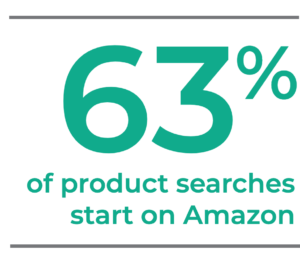 Advertising channels and platforms are constantly expanding. The result is that consumers find products and brands in a lot of different ways today. That makes connecting with and attracting customers more and more challenging.
Advertising channels and platforms are constantly expanding. The result is that consumers find products and brands in a lot of different ways today. That makes connecting with and attracting customers more and more challenging.
Consider:
- 63% of product searches start on Amazon.11
- 66% of people prefer a short video over text to learn about a product.12
- 49% of consumers follow the recommendations of influencers.13
The Takeaway
Be adaptive! Empower your team to look into new channels, new trends, and new opportunities.
Finch helped METRO Markets add Google Shopping Ads campaigns to the search campaigns METRO was already running. With Finch automated optimization used to manage those campaigns, METRO realized 3.7 million visits from just those Shopping Ads campaigns in nine months!
If selling on Amazon is viable for you and you aren’t today, it may be worth looking into. And if you’ve never used video, it could be worth trying one or two and seeing how they convert.
With a solid cross-channel strategy and efficient advertising management solution, you can use data and insights across platforms. For example, you can use high-performing keywords and creative as well as audience information from Google Shopping Ads campaigns to maximize Amazon Advertising campaigns.
If you’ve never done display advertising, maybe it’s time to consider it as a way to reach your customer with the right messaging at the right time during their buying journey to increase both awareness and conversions. Up to 95% of purchases made by customers of Finch clients are tied to view-through conversions from display ads.
4. Increased Importance in Using Technologies to Automate
With all the complexity of eCommerce and to ensure you maximize on the opportunities, technology can be your best friend. Not any technology though, the right technology.
 The right technology spans content management systems, backend or headless eCommerce platforms, logistics and delivery providers, marketing platforms, and more. An ideal technology gives you a single source or seamless integration with your other technologies, so you can maximize efficiency.
The right technology spans content management systems, backend or headless eCommerce platforms, logistics and delivery providers, marketing platforms, and more. An ideal technology gives you a single source or seamless integration with your other technologies, so you can maximize efficiency.
The technologies that are top of mind for eCommerce and online marketers in 2021 are artificial intelligence (AI) and cross-channel advertising management solutions.
Artificial Intelligence
AI or machine learning is the use of algorithms to learn from repeat patterns. Siri and Cortana use AI to learn how to better interpret and answer user questions over time. AI algorithms are behind Google Smart Shopping. Search engine and voice search results also use algorithms to deliver the best results.
Similarly, paid marketing platforms, known as advertising management platforms, use AI to help digital marketers automatically optimize search and shopping campaigns. Platforms, like the Finch Advertising Management Platform, learn from historical and ongoing performance data to deliver the most relevant, best-converting campaigns.
The advantage of AI is that it can move much faster than people. The Finch Platform automates thousands of changes a week and across multiple channels and campaign types. It automated more than 62,000 changes during the first week for one Finch client. That’s a level of optimization not possible unless you have dozens of finely synced experts on staff.
With AI, your team is free from manual adjustments and can focus on strategy and other activities instead of manually optimizing ads.
Cross-Channel Advertising Management Solutions
Due to the increasing number of channels and increasing ways to reach customers, a platform that lets teams manage and report on multiple channels — search, shopping, display, and social — and across platforms in a single place is a game-changer.
The ability to look at data across Amazon Advertising, Google Search and Shopping Campaigns, and Facebook Shops and use that data to optimize all channels and campaigns can help your team move at a much faster, more effective pace while maintaining a stable ROAS.
The Takeaway
The right technologies are time savers. They can also help you stay agile, maximize performance and ROAS, and move faster than the competition, which gives you the competitive advantage.
5. Continuing Uncertainty
A significant eCommerce challenge in 2021 will be continued uncertainty. Not just the uncertainty resulting from COVID-19, but the everyday uncertainty that a rapidly changing industry and technologies bring.
Finch Account Director Ciara Naas summed up the need for agility in the face of 2021 during the “Profitable, Cost-Effective Growth for eCommerce Webinar” in November.
The Takeaway
Expect the unexpected and stay as agile and innovative as you can in 2021. Don’t forget to stay strategic too. That sounds like a contradiction to being agile, but strategy will help guide you as you move forward. You want to focus on your best converting ads while retaining the flexibility you need to pivot and adjust your campaigns and strategy as needed.
The Finch Strategic Services team helps eCommerce companies worldwide develop and regularly refine strategies using Finch Insights reporting and Collaboration in the Finch Platform. If you want help refining your strategy, contact Finch to see how we can help.
1 eMarketer, US eCommerce Growth Jumps to More than 30%, Accelerating Online Shopping Shift by Nearly 2 Years, Oct. 2020, www.emarketer.com/content/us-eCommerce-growth-jumps-more-than-30-accelerating-online-shopping-shift-by-nearly-2-years
2 BusinessWire, eCommerce Transactions Remain High During Pandemic — Outdoor Equipment Sales Highest Since Start of Summer According to Latest ACI Worldwide Data, Aug. 2020, www.businesswire.com/news/home/20200811005779/en/eCommerce-Transactions-Remain-High-Pandemic
3 eMarketer, US eCommerce Sales Grew by Nearly a Third in Q2, Sept. 2020, www.emarketer.com/content/us-eCommerce-sales-grew-by-nearly-third-q2
4 PYMNTS.com, FTC Reports Record Surge In eCommerce Complaints Amid Pandemic, July 2020, www.pymnts.com/news/retail/2020/ftc-reports-record-surge-in-eCommerce-complaints-amid-pandemic/
5 Inquirer.net, ‘Significant’ increase in consumer complaints on online transactions reported in 2020, Nov. 2020, business.inquirer.net/311398/significant-increase-in-consumer-complaints-vs-online-transactions-reported-in-2020
6 Yieldify, E-commerce Adoption of Website Personalization Reached 74% During COVID, Aug. 2020, www.yieldify.com/news/eCommerce-website-personalization-adoption-new-yieldify-report/
7 Modern retail, How local e-commerce platforms are trying to challenge Amazon’s dominance, Nov. 2020, www.modernretail.co/platforms/how-local-e-commerce-platforms-are-trying-to-challenge-amazons-dominance/
8 Retail Today, Cross-border eCommerce Retail Sales Rising: Global-e Report Shows Strong Trading Across Regions and Verticals, July 2020, etail-today.com/cross-border-eCommerce-retail-sales-rising-global-e-report-shows-strong-trading-across-regions-and-verticals/
9 eCommerce News Europe, 24% of eCommerce in Europe is cross-border, June 2020, eCommercenews.eu/24-of-eCommerce-in-europe-is-cross-border/
10 Contact Pigeon Blog, Gartner Trends 2020 Predictions: What They Mean for Retailers, Feb. 2020, blog.contactpigeon.com/gartner-trends-2020/#subscription-commerce
11 Statista, Most popular online marketplaces worldwide in 2019, based on gross merchandise value. Statista, Apr. 2020, www.statista.com/statistics/885354/top-global-online-marketplaces-by-gmv/
12 Wyzowl.com, Video Marketing Statistics 2020, www.wyzowl.com/video-marketing-statistics-2020/
13 Digital Marketing Institute, 20 Key Influencer Marketing Statistics That Will Surprise You, digitalmarketinginstitute.com/blog/20-influencer-marketing-statistics-that-will-surprise-you






